Roles and Characteristics of a Leader and a Manager
VerifiedAdded on 2023/01/11
|14
|3943
|100
AI Summary
This article discusses the roles and characteristics of a leader and a manager in an organization. It explores the different responsibilities and qualities that leaders and managers possess. The content also includes the application of situational leadership, systems leadership, and contingency theory in a business context.
Contribute Materials
Your contribution can guide someone’s learning journey. Share your
documents today.
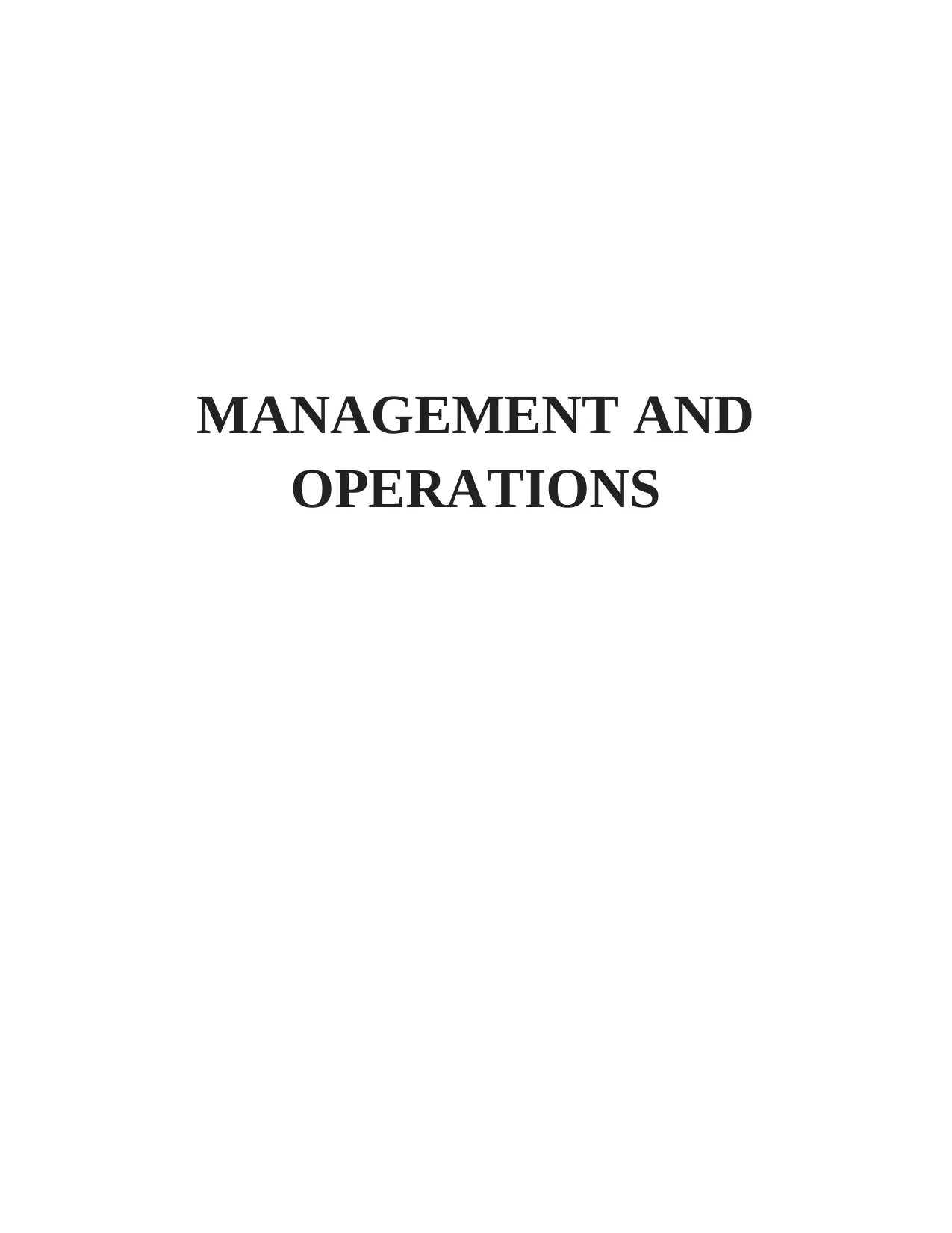
MANAGEMENT AND
OPERATIONS
OPERATIONS
Secure Best Marks with AI Grader
Need help grading? Try our AI Grader for instant feedback on your assignments.
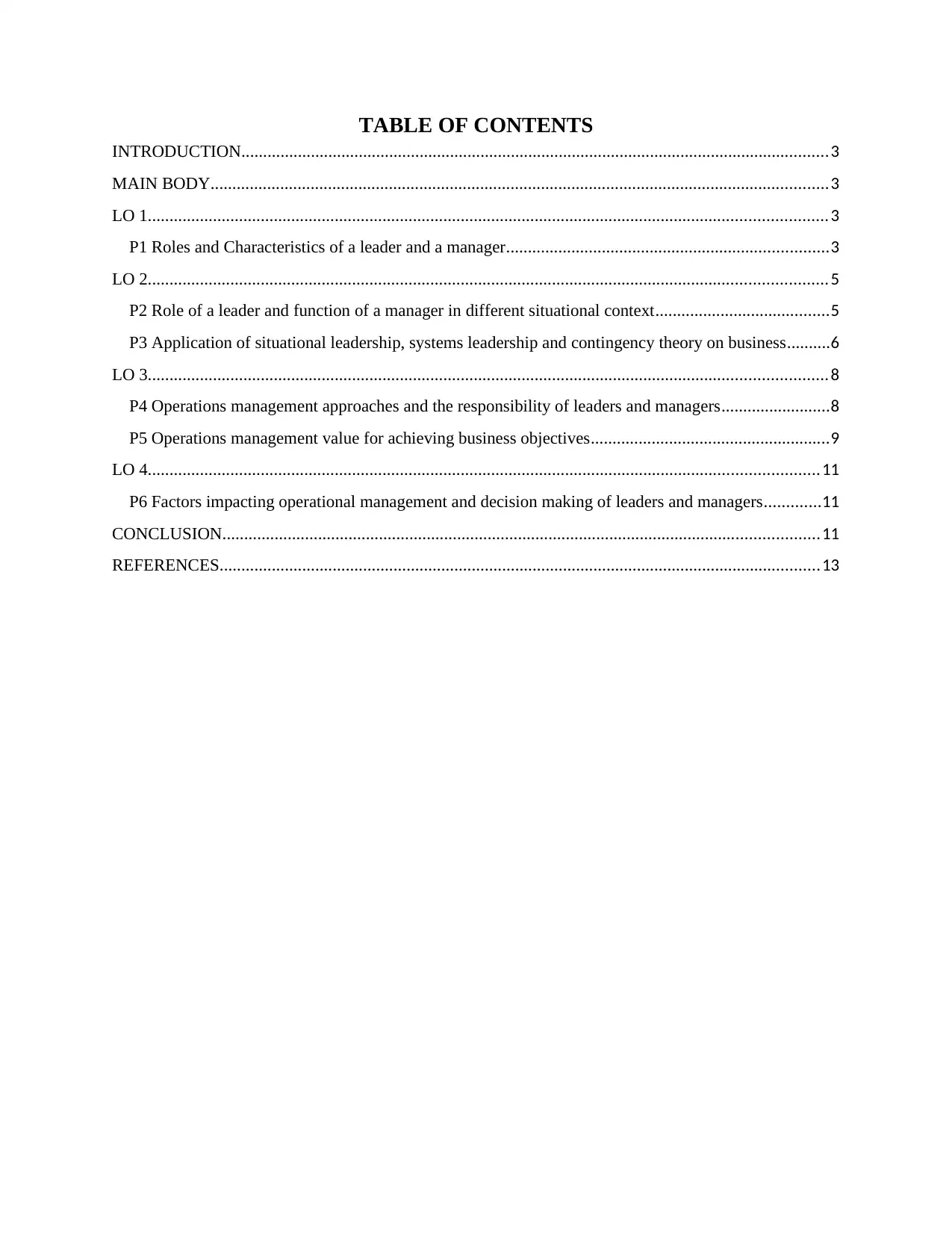
TABLE OF CONTENTS
INTRODUCTION.......................................................................................................................................3
MAIN BODY..............................................................................................................................................3
LO 1............................................................................................................................................................3
P1 Roles and Characteristics of a leader and a manager..........................................................................3
LO 2............................................................................................................................................................5
P2 Role of a leader and function of a manager in different situational context........................................5
P3 Application of situational leadership, systems leadership and contingency theory on business..........6
LO 3............................................................................................................................................................8
P4 Operations management approaches and the responsibility of leaders and managers.........................8
P5 Operations management value for achieving business objectives.......................................................9
LO 4..........................................................................................................................................................11
P6 Factors impacting operational management and decision making of leaders and managers.............11
CONCLUSION.........................................................................................................................................11
REFERENCES..........................................................................................................................................13
INTRODUCTION.......................................................................................................................................3
MAIN BODY..............................................................................................................................................3
LO 1............................................................................................................................................................3
P1 Roles and Characteristics of a leader and a manager..........................................................................3
LO 2............................................................................................................................................................5
P2 Role of a leader and function of a manager in different situational context........................................5
P3 Application of situational leadership, systems leadership and contingency theory on business..........6
LO 3............................................................................................................................................................8
P4 Operations management approaches and the responsibility of leaders and managers.........................8
P5 Operations management value for achieving business objectives.......................................................9
LO 4..........................................................................................................................................................11
P6 Factors impacting operational management and decision making of leaders and managers.............11
CONCLUSION.........................................................................................................................................11
REFERENCES..........................................................................................................................................13
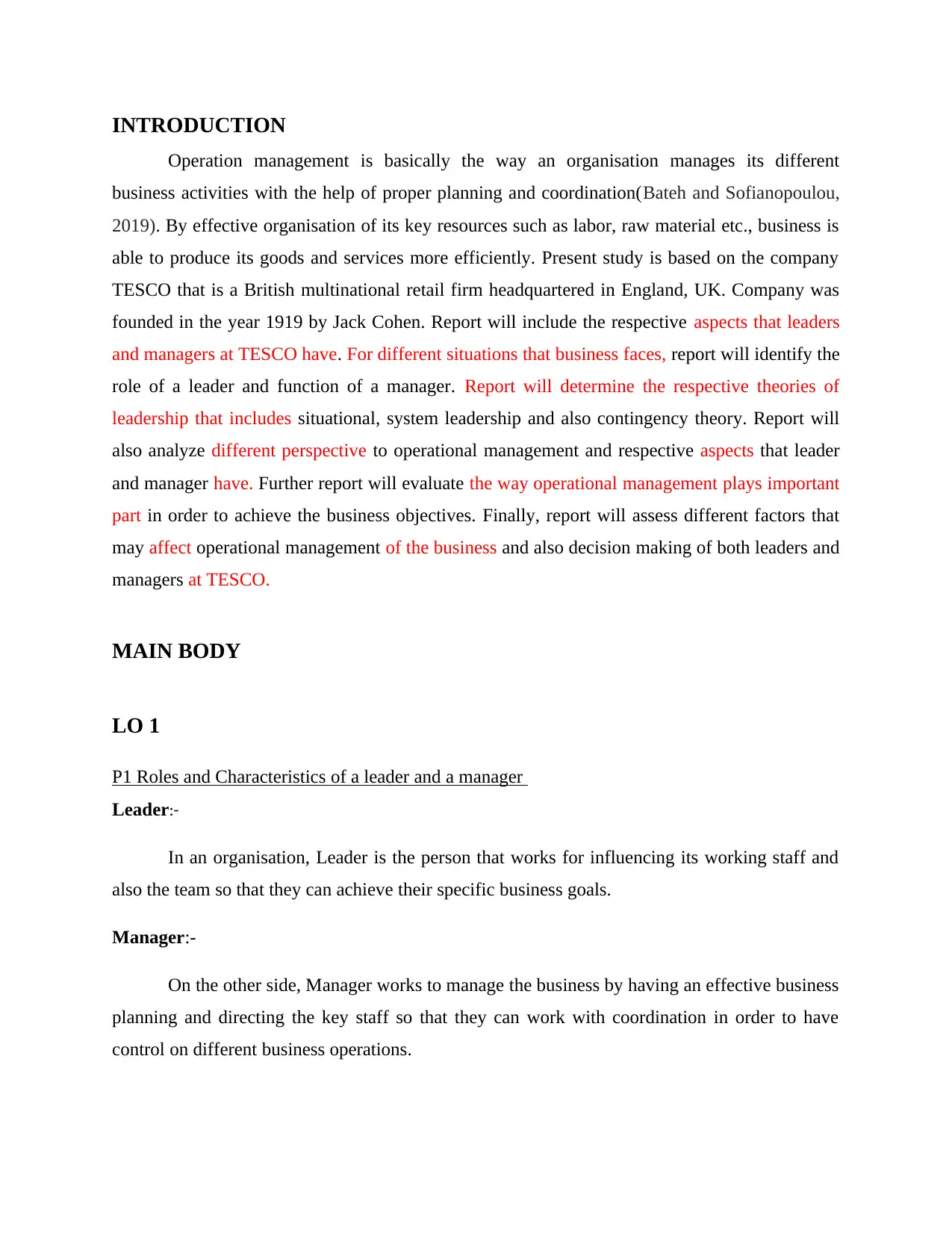
INTRODUCTION
Operation management is basically the way an organisation manages its different
business activities with the help of proper planning and coordination(Bateh and Sofianopoulou,
2019). By effective organisation of its key resources such as labor, raw material etc., business is
able to produce its goods and services more efficiently. Present study is based on the company
TESCO that is a British multinational retail firm headquartered in England, UK. Company was
founded in the year 1919 by Jack Cohen. Report will include the respective aspects that leaders
and managers at TESCO have. For different situations that business faces, report will identify the
role of a leader and function of a manager. Report will determine the respective theories of
leadership that includes situational, system leadership and also contingency theory. Report will
also analyze different perspective to operational management and respective aspects that leader
and manager have. Further report will evaluate the way operational management plays important
part in order to achieve the business objectives. Finally, report will assess different factors that
may affect operational management of the business and also decision making of both leaders and
managers at TESCO.
MAIN BODY
LO 1
P1 Roles and Characteristics of a leader and a manager
Leader:-
In an organisation, Leader is the person that works for influencing its working staff and
also the team so that they can achieve their specific business goals.
Manager:-
On the other side, Manager works to manage the business by having an effective business
planning and directing the key staff so that they can work with coordination in order to have
control on different business operations.
Operation management is basically the way an organisation manages its different
business activities with the help of proper planning and coordination(Bateh and Sofianopoulou,
2019). By effective organisation of its key resources such as labor, raw material etc., business is
able to produce its goods and services more efficiently. Present study is based on the company
TESCO that is a British multinational retail firm headquartered in England, UK. Company was
founded in the year 1919 by Jack Cohen. Report will include the respective aspects that leaders
and managers at TESCO have. For different situations that business faces, report will identify the
role of a leader and function of a manager. Report will determine the respective theories of
leadership that includes situational, system leadership and also contingency theory. Report will
also analyze different perspective to operational management and respective aspects that leader
and manager have. Further report will evaluate the way operational management plays important
part in order to achieve the business objectives. Finally, report will assess different factors that
may affect operational management of the business and also decision making of both leaders and
managers at TESCO.
MAIN BODY
LO 1
P1 Roles and Characteristics of a leader and a manager
Leader:-
In an organisation, Leader is the person that works for influencing its working staff and
also the team so that they can achieve their specific business goals.
Manager:-
On the other side, Manager works to manage the business by having an effective business
planning and directing the key staff so that they can work with coordination in order to have
control on different business operations.
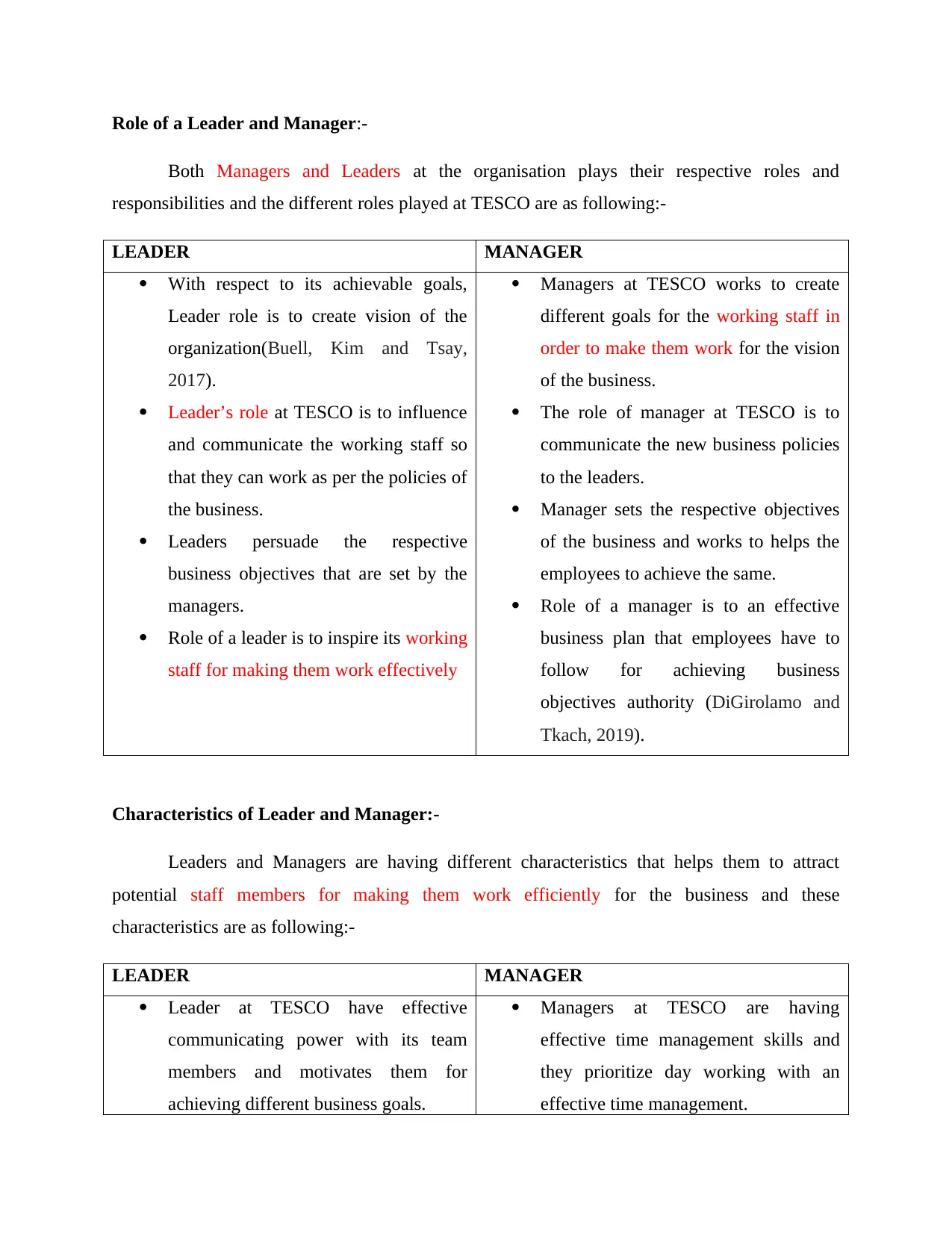
Role of a Leader and Manager:-
Both Managers and Leaders at the organisation plays their respective roles and
responsibilities and the different roles played at TESCO are as following:-
LEADER MANAGER
With respect to its achievable goals,
Leader role is to create vision of the
organization(Buell, Kim and Tsay,
2017).
Leader’s role at TESCO is to influence
and communicate the working staff so
that they can work as per the policies of
the business.
Leaders persuade the respective
business objectives that are set by the
managers.
Role of a leader is to inspire its working
staff for making them work effectively
Managers at TESCO works to create
different goals for the working staff in
order to make them work for the vision
of the business.
The role of manager at TESCO is to
communicate the new business policies
to the leaders.
Manager sets the respective objectives
of the business and works to helps the
employees to achieve the same.
Role of a manager is to an effective
business plan that employees have to
follow for achieving business
objectives authority (DiGirolamo and
Tkach, 2019).
Characteristics of Leader and Manager:-
Leaders and Managers are having different characteristics that helps them to attract
potential staff members for making them work efficiently for the business and these
characteristics are as following:-
LEADER MANAGER
Leader at TESCO have effective
communicating power with its team
members and motivates them for
achieving different business goals.
Managers at TESCO are having
effective time management skills and
they prioritize day working with an
effective time management.
Both Managers and Leaders at the organisation plays their respective roles and
responsibilities and the different roles played at TESCO are as following:-
LEADER MANAGER
With respect to its achievable goals,
Leader role is to create vision of the
organization(Buell, Kim and Tsay,
2017).
Leader’s role at TESCO is to influence
and communicate the working staff so
that they can work as per the policies of
the business.
Leaders persuade the respective
business objectives that are set by the
managers.
Role of a leader is to inspire its working
staff for making them work effectively
Managers at TESCO works to create
different goals for the working staff in
order to make them work for the vision
of the business.
The role of manager at TESCO is to
communicate the new business policies
to the leaders.
Manager sets the respective objectives
of the business and works to helps the
employees to achieve the same.
Role of a manager is to an effective
business plan that employees have to
follow for achieving business
objectives authority (DiGirolamo and
Tkach, 2019).
Characteristics of Leader and Manager:-
Leaders and Managers are having different characteristics that helps them to attract
potential staff members for making them work efficiently for the business and these
characteristics are as following:-
LEADER MANAGER
Leader at TESCO have effective
communicating power with its team
members and motivates them for
achieving different business goals.
Managers at TESCO are having
effective time management skills and
they prioritize day working with an
effective time management.
Secure Best Marks with AI Grader
Need help grading? Try our AI Grader for instant feedback on your assignments.
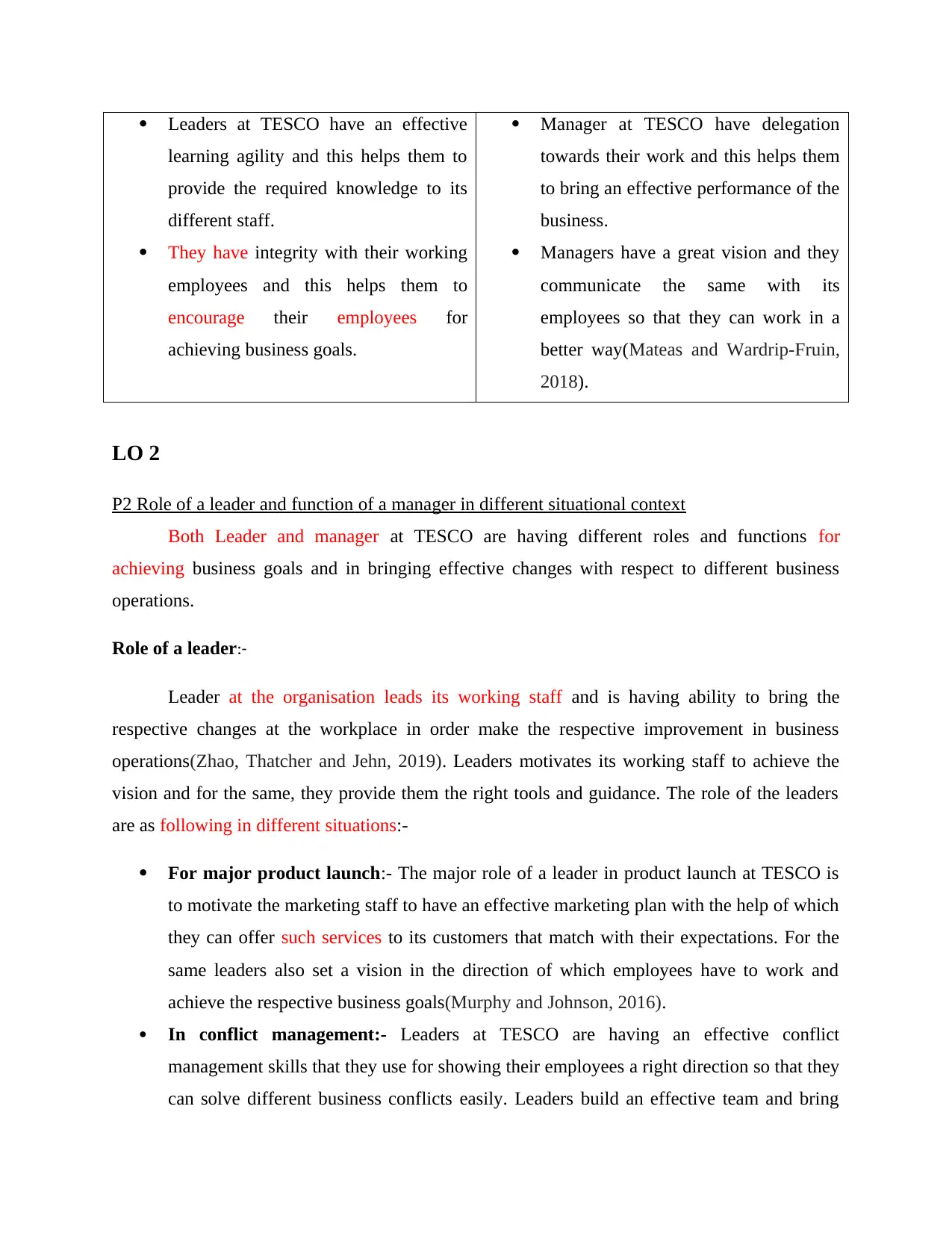
Leaders at TESCO have an effective
learning agility and this helps them to
provide the required knowledge to its
different staff.
They have integrity with their working
employees and this helps them to
encourage their employees for
achieving business goals.
Manager at TESCO have delegation
towards their work and this helps them
to bring an effective performance of the
business.
Managers have a great vision and they
communicate the same with its
employees so that they can work in a
better way(Mateas and Wardrip-Fruin,
2018).
LO 2
P2 Role of a leader and function of a manager in different situational context
Both Leader and manager at TESCO are having different roles and functions for
achieving business goals and in bringing effective changes with respect to different business
operations.
Role of a leader:-
Leader at the organisation leads its working staff and is having ability to bring the
respective changes at the workplace in order make the respective improvement in business
operations(Zhao, Thatcher and Jehn, 2019). Leaders motivates its working staff to achieve the
vision and for the same, they provide them the right tools and guidance. The role of the leaders
are as following in different situations:-
For major product launch:- The major role of a leader in product launch at TESCO is
to motivate the marketing staff to have an effective marketing plan with the help of which
they can offer such services to its customers that match with their expectations. For the
same leaders also set a vision in the direction of which employees have to work and
achieve the respective business goals(Murphy and Johnson, 2016).
In conflict management:- Leaders at TESCO are having an effective conflict
management skills that they use for showing their employees a right direction so that they
can solve different business conflicts easily. Leaders build an effective team and bring
learning agility and this helps them to
provide the required knowledge to its
different staff.
They have integrity with their working
employees and this helps them to
encourage their employees for
achieving business goals.
Manager at TESCO have delegation
towards their work and this helps them
to bring an effective performance of the
business.
Managers have a great vision and they
communicate the same with its
employees so that they can work in a
better way(Mateas and Wardrip-Fruin,
2018).
LO 2
P2 Role of a leader and function of a manager in different situational context
Both Leader and manager at TESCO are having different roles and functions for
achieving business goals and in bringing effective changes with respect to different business
operations.
Role of a leader:-
Leader at the organisation leads its working staff and is having ability to bring the
respective changes at the workplace in order make the respective improvement in business
operations(Zhao, Thatcher and Jehn, 2019). Leaders motivates its working staff to achieve the
vision and for the same, they provide them the right tools and guidance. The role of the leaders
are as following in different situations:-
For major product launch:- The major role of a leader in product launch at TESCO is
to motivate the marketing staff to have an effective marketing plan with the help of which
they can offer such services to its customers that match with their expectations. For the
same leaders also set a vision in the direction of which employees have to work and
achieve the respective business goals(Murphy and Johnson, 2016).
In conflict management:- Leaders at TESCO are having an effective conflict
management skills that they use for showing their employees a right direction so that they
can solve different business conflicts easily. Leaders build an effective team and bring

new level of understanding within the staff that works effectively to deal with different
business issues.
Function of a Manager:-
Managers at TESCO are having their key responsibility to have a control over the staff
members. They plan different schedule for their employees and make them work on bases of the
specific plan. They monitor the staff members and guide them so that they can handle different
issues more effectively. The different functions that managers have are as following:-
Major product and service launch:- Managers at TESCO are having its major function
to build an effective plan so that they are able to launch its new projects effectively. They
work to allocate important resources for launching products and services that match with
the expectations of the customers(Kumar and et.al., 2017).
Conflict management:- Function of manager at TESCO for managing different conflicts
is to guide the working staff so that there is no delay in their work. Managers at TESCO
are having effective decision making skills with the help of which they comes with
effective solutions in order to solve different business problems. All this is done with the
help of a two way communication with the employees as it helps them to understand
what problems they are facing during the management of different conflicts that are
arising at the business (Raines, 2019).
P3 Application of situational leadership, systems leadership and contingency theory on business
Situational leadership:-
On bases of different situations that are arising at the firm, managers of TESCO are using
different leadership styles and that helps the business to deal with different organisational
situations. The respective leadership styles are as following:-
Telling and Directing:- With the help of this leadership style, leaders at TESCO makes
an effective business decisions on their own and convey the same to its working staff so
that they work accordingly. The leaders have a key eye on their working employees and
they have to follow the guidance of the respective leaders.
business issues.
Function of a Manager:-
Managers at TESCO are having their key responsibility to have a control over the staff
members. They plan different schedule for their employees and make them work on bases of the
specific plan. They monitor the staff members and guide them so that they can handle different
issues more effectively. The different functions that managers have are as following:-
Major product and service launch:- Managers at TESCO are having its major function
to build an effective plan so that they are able to launch its new projects effectively. They
work to allocate important resources for launching products and services that match with
the expectations of the customers(Kumar and et.al., 2017).
Conflict management:- Function of manager at TESCO for managing different conflicts
is to guide the working staff so that there is no delay in their work. Managers at TESCO
are having effective decision making skills with the help of which they comes with
effective solutions in order to solve different business problems. All this is done with the
help of a two way communication with the employees as it helps them to understand
what problems they are facing during the management of different conflicts that are
arising at the business (Raines, 2019).
P3 Application of situational leadership, systems leadership and contingency theory on business
Situational leadership:-
On bases of different situations that are arising at the firm, managers of TESCO are using
different leadership styles and that helps the business to deal with different organisational
situations. The respective leadership styles are as following:-
Telling and Directing:- With the help of this leadership style, leaders at TESCO makes
an effective business decisions on their own and convey the same to its working staff so
that they work accordingly. The leaders have a key eye on their working employees and
they have to follow the guidance of the respective leaders.

Selling and Coaching:- With this leadership style, the leaders at the TESCO allow its
working employees to give their own ideas and the final decision is generally made the
leader itself. The leader gives effective training to its employees and supervises their
respective performance. They praise their working staff and build their confidence so that
their daily business activities can be improved(Lynch and et.al., 2018).
Participating and supporting:- With the help of this leadership style, the leaders put
responsibility on its working staff and guide them in right direction and give them
feedbacks so that they come up with right decision as the final decision is of the
employees only. For the same, they motivate them and work for correcting their mistakes.
Delegating to employees:- The employees here are set free to take their own decisions for
their respective work and tasks. Leaders with this leadership style at TESCO are less
involved with their employees and the feedback given by them is of lower level.
Considering development level:- The leadership style used by the leaders is based on the
level of development of TESCO that is the less experienced employees are guided with
the help of directing style and the staff that is having high competence will be guided
with delegating style of leadership.
Generally, the leaders at TESCO use telling and directing leadership style for different
situational context and this helps them to come with an effective product and service launch.
Not only this, the leaders are also able to manage different conflicts at the business with the
help of its potential employees.
Systems leadership:-
With this leadership style, leaders at TESCO are able to create an effective working
condition for its staff members in order to have more productively. There are certain sets of skills
that these leaders at TESCO use for the systems level change and their major role is to catalyzing
and supporting various actions of the business. This leadership style usually helps the leader to
bring certain sets of actions by which they are able to solve their complex challenges
easily(Boylan, 2016). The leaders here, involve all its stakeholders in order to solve different
business issues and takes effective decision for the business with mutual discussion with the
employees.
working employees to give their own ideas and the final decision is generally made the
leader itself. The leader gives effective training to its employees and supervises their
respective performance. They praise their working staff and build their confidence so that
their daily business activities can be improved(Lynch and et.al., 2018).
Participating and supporting:- With the help of this leadership style, the leaders put
responsibility on its working staff and guide them in right direction and give them
feedbacks so that they come up with right decision as the final decision is of the
employees only. For the same, they motivate them and work for correcting their mistakes.
Delegating to employees:- The employees here are set free to take their own decisions for
their respective work and tasks. Leaders with this leadership style at TESCO are less
involved with their employees and the feedback given by them is of lower level.
Considering development level:- The leadership style used by the leaders is based on the
level of development of TESCO that is the less experienced employees are guided with
the help of directing style and the staff that is having high competence will be guided
with delegating style of leadership.
Generally, the leaders at TESCO use telling and directing leadership style for different
situational context and this helps them to come with an effective product and service launch.
Not only this, the leaders are also able to manage different conflicts at the business with the
help of its potential employees.
Systems leadership:-
With this leadership style, leaders at TESCO are able to create an effective working
condition for its staff members in order to have more productively. There are certain sets of skills
that these leaders at TESCO use for the systems level change and their major role is to catalyzing
and supporting various actions of the business. This leadership style usually helps the leader to
bring certain sets of actions by which they are able to solve their complex challenges
easily(Boylan, 2016). The leaders here, involve all its stakeholders in order to solve different
business issues and takes effective decision for the business with mutual discussion with the
employees.
Paraphrase This Document
Need a fresh take? Get an instant paraphrase of this document with our AI Paraphraser
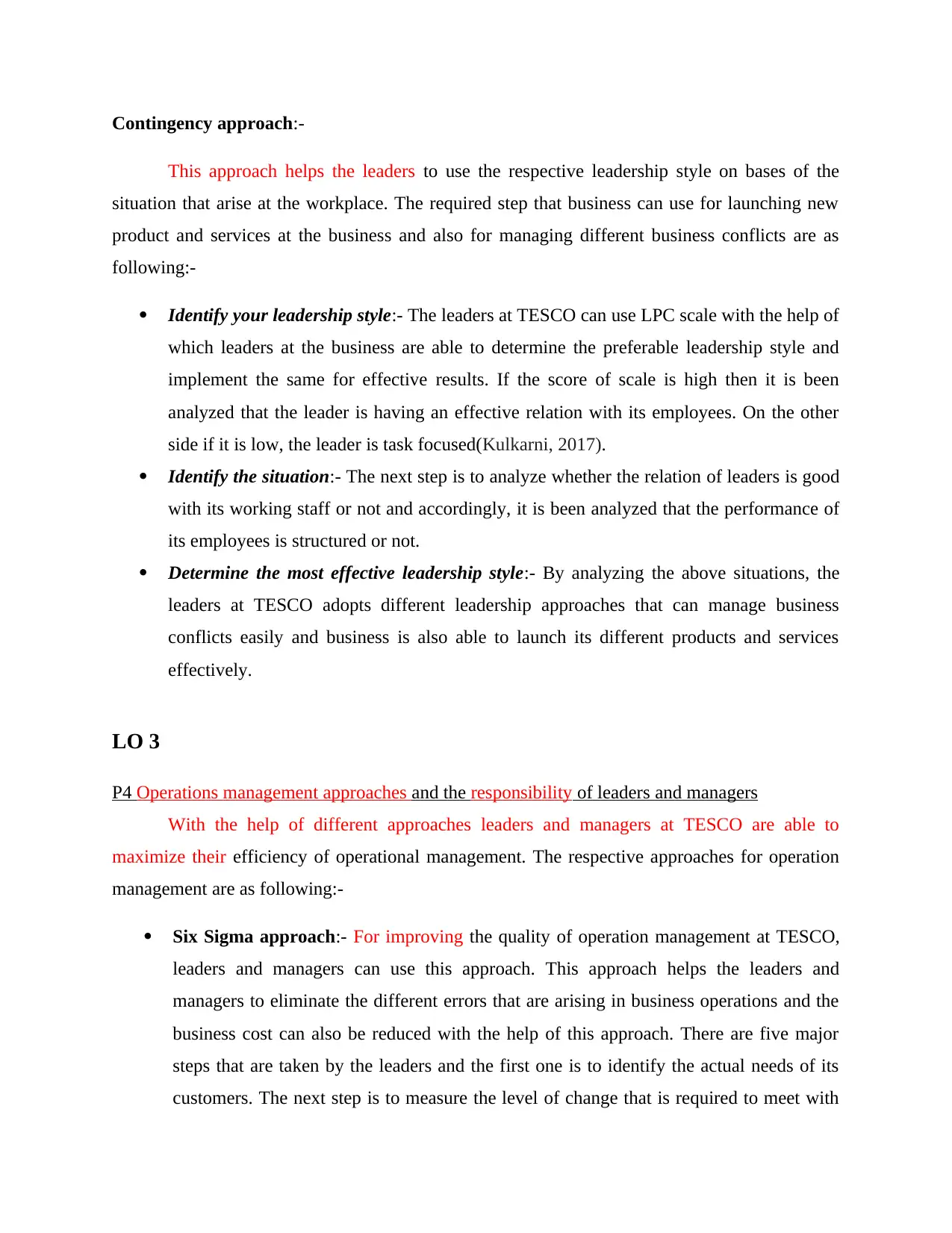
Contingency approach:-
This approach helps the leaders to use the respective leadership style on bases of the
situation that arise at the workplace. The required step that business can use for launching new
product and services at the business and also for managing different business conflicts are as
following:-
Identify your leadership style:- The leaders at TESCO can use LPC scale with the help of
which leaders at the business are able to determine the preferable leadership style and
implement the same for effective results. If the score of scale is high then it is been
analyzed that the leader is having an effective relation with its employees. On the other
side if it is low, the leader is task focused(Kulkarni, 2017).
Identify the situation:- The next step is to analyze whether the relation of leaders is good
with its working staff or not and accordingly, it is been analyzed that the performance of
its employees is structured or not.
Determine the most effective leadership style:- By analyzing the above situations, the
leaders at TESCO adopts different leadership approaches that can manage business
conflicts easily and business is also able to launch its different products and services
effectively.
LO 3
P4 Operations management approaches and the responsibility of leaders and managers
With the help of different approaches leaders and managers at TESCO are able to
maximize their efficiency of operational management. The respective approaches for operation
management are as following:-
Six Sigma approach:- For improving the quality of operation management at TESCO,
leaders and managers can use this approach. This approach helps the leaders and
managers to eliminate the different errors that are arising in business operations and the
business cost can also be reduced with the help of this approach. There are five major
steps that are taken by the leaders and the first one is to identify the actual needs of its
customers. The next step is to measure the level of change that is required to meet with
This approach helps the leaders to use the respective leadership style on bases of the
situation that arise at the workplace. The required step that business can use for launching new
product and services at the business and also for managing different business conflicts are as
following:-
Identify your leadership style:- The leaders at TESCO can use LPC scale with the help of
which leaders at the business are able to determine the preferable leadership style and
implement the same for effective results. If the score of scale is high then it is been
analyzed that the leader is having an effective relation with its employees. On the other
side if it is low, the leader is task focused(Kulkarni, 2017).
Identify the situation:- The next step is to analyze whether the relation of leaders is good
with its working staff or not and accordingly, it is been analyzed that the performance of
its employees is structured or not.
Determine the most effective leadership style:- By analyzing the above situations, the
leaders at TESCO adopts different leadership approaches that can manage business
conflicts easily and business is also able to launch its different products and services
effectively.
LO 3
P4 Operations management approaches and the responsibility of leaders and managers
With the help of different approaches leaders and managers at TESCO are able to
maximize their efficiency of operational management. The respective approaches for operation
management are as following:-
Six Sigma approach:- For improving the quality of operation management at TESCO,
leaders and managers can use this approach. This approach helps the leaders and
managers to eliminate the different errors that are arising in business operations and the
business cost can also be reduced with the help of this approach. There are five major
steps that are taken by the leaders and the first one is to identify the actual needs of its
customers. The next step is to measure the level of change that is required to meet with
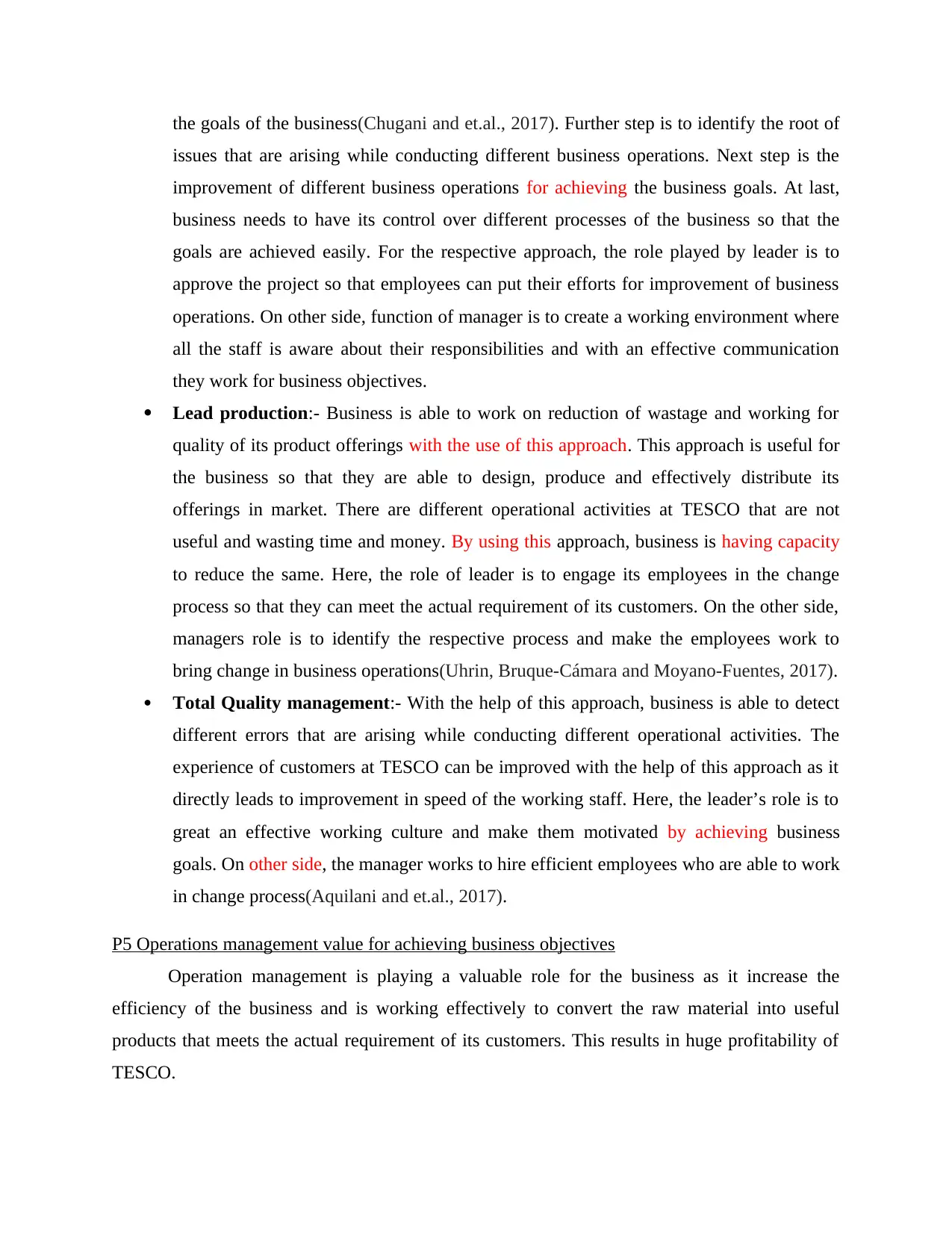
the goals of the business(Chugani and et.al., 2017). Further step is to identify the root of
issues that are arising while conducting different business operations. Next step is the
improvement of different business operations for achieving the business goals. At last,
business needs to have its control over different processes of the business so that the
goals are achieved easily. For the respective approach, the role played by leader is to
approve the project so that employees can put their efforts for improvement of business
operations. On other side, function of manager is to create a working environment where
all the staff is aware about their responsibilities and with an effective communication
they work for business objectives.
Lead production:- Business is able to work on reduction of wastage and working for
quality of its product offerings with the use of this approach. This approach is useful for
the business so that they are able to design, produce and effectively distribute its
offerings in market. There are different operational activities at TESCO that are not
useful and wasting time and money. By using this approach, business is having capacity
to reduce the same. Here, the role of leader is to engage its employees in the change
process so that they can meet the actual requirement of its customers. On the other side,
managers role is to identify the respective process and make the employees work to
bring change in business operations(Uhrin, Bruque-Cámara and Moyano-Fuentes, 2017).
Total Quality management:- With the help of this approach, business is able to detect
different errors that are arising while conducting different operational activities. The
experience of customers at TESCO can be improved with the help of this approach as it
directly leads to improvement in speed of the working staff. Here, the leader’s role is to
great an effective working culture and make them motivated by achieving business
goals. On other side, the manager works to hire efficient employees who are able to work
in change process(Aquilani and et.al., 2017).
P5 Operations management value for achieving business objectives
Operation management is playing a valuable role for the business as it increase the
efficiency of the business and is working effectively to convert the raw material into useful
products that meets the actual requirement of its customers. This results in huge profitability of
TESCO.
issues that are arising while conducting different business operations. Next step is the
improvement of different business operations for achieving the business goals. At last,
business needs to have its control over different processes of the business so that the
goals are achieved easily. For the respective approach, the role played by leader is to
approve the project so that employees can put their efforts for improvement of business
operations. On other side, function of manager is to create a working environment where
all the staff is aware about their responsibilities and with an effective communication
they work for business objectives.
Lead production:- Business is able to work on reduction of wastage and working for
quality of its product offerings with the use of this approach. This approach is useful for
the business so that they are able to design, produce and effectively distribute its
offerings in market. There are different operational activities at TESCO that are not
useful and wasting time and money. By using this approach, business is having capacity
to reduce the same. Here, the role of leader is to engage its employees in the change
process so that they can meet the actual requirement of its customers. On the other side,
managers role is to identify the respective process and make the employees work to
bring change in business operations(Uhrin, Bruque-Cámara and Moyano-Fuentes, 2017).
Total Quality management:- With the help of this approach, business is able to detect
different errors that are arising while conducting different operational activities. The
experience of customers at TESCO can be improved with the help of this approach as it
directly leads to improvement in speed of the working staff. Here, the leader’s role is to
great an effective working culture and make them motivated by achieving business
goals. On other side, the manager works to hire efficient employees who are able to work
in change process(Aquilani and et.al., 2017).
P5 Operations management value for achieving business objectives
Operation management is playing a valuable role for the business as it increase the
efficiency of the business and is working effectively to convert the raw material into useful
products that meets the actual requirement of its customers. This results in huge profitability of
TESCO.

The operational functions that are helping TESCO for achieving different objectives are as
following:-
Control and distribution systems:- This operational management system works to have a
look on the transfer of business goods from the respective manufactures to the sales
department.
Transformation of raw material into finished goods and services:- The operational
management works to transform the raw materials into the desirable finished goods that
meets the expectation of the customers. The manager works to have an effective plan and
control on their business operations(Reid and Sanders, 2019).
Process design:- The other most important function of operational management is to
design the respective process and for the same, product is divided into sub parts with the
help of an effective strategy.
There are certain objectives of the TESCO that can be achieved from operational
management and are as following:-
Enhancing quality of products and services:- The control and distribution system helps
the business to enhance the quality of its product and services. For the same an effective
improvement plan can be initiated by the business. Distribution system helps TESCO to
make its customers satisfied with a quality of its offering(Ravinder and Kollikkathara,
2017).
The reduction of wastage:- The process design helps the business to have control on the
wastage and TESCO can take help of an effective process design in order to prevent
wastage that occurs during packaging or in other business activities.
Profitability:- Business is able to make huge profitability by transforming raw materials
into something useful that matches with the needs of its customers. TESCO can achieve
its business objective by adding value to its finished products and services.
following:-
Control and distribution systems:- This operational management system works to have a
look on the transfer of business goods from the respective manufactures to the sales
department.
Transformation of raw material into finished goods and services:- The operational
management works to transform the raw materials into the desirable finished goods that
meets the expectation of the customers. The manager works to have an effective plan and
control on their business operations(Reid and Sanders, 2019).
Process design:- The other most important function of operational management is to
design the respective process and for the same, product is divided into sub parts with the
help of an effective strategy.
There are certain objectives of the TESCO that can be achieved from operational
management and are as following:-
Enhancing quality of products and services:- The control and distribution system helps
the business to enhance the quality of its product and services. For the same an effective
improvement plan can be initiated by the business. Distribution system helps TESCO to
make its customers satisfied with a quality of its offering(Ravinder and Kollikkathara,
2017).
The reduction of wastage:- The process design helps the business to have control on the
wastage and TESCO can take help of an effective process design in order to prevent
wastage that occurs during packaging or in other business activities.
Profitability:- Business is able to make huge profitability by transforming raw materials
into something useful that matches with the needs of its customers. TESCO can achieve
its business objective by adding value to its finished products and services.
Secure Best Marks with AI Grader
Need help grading? Try our AI Grader for instant feedback on your assignments.
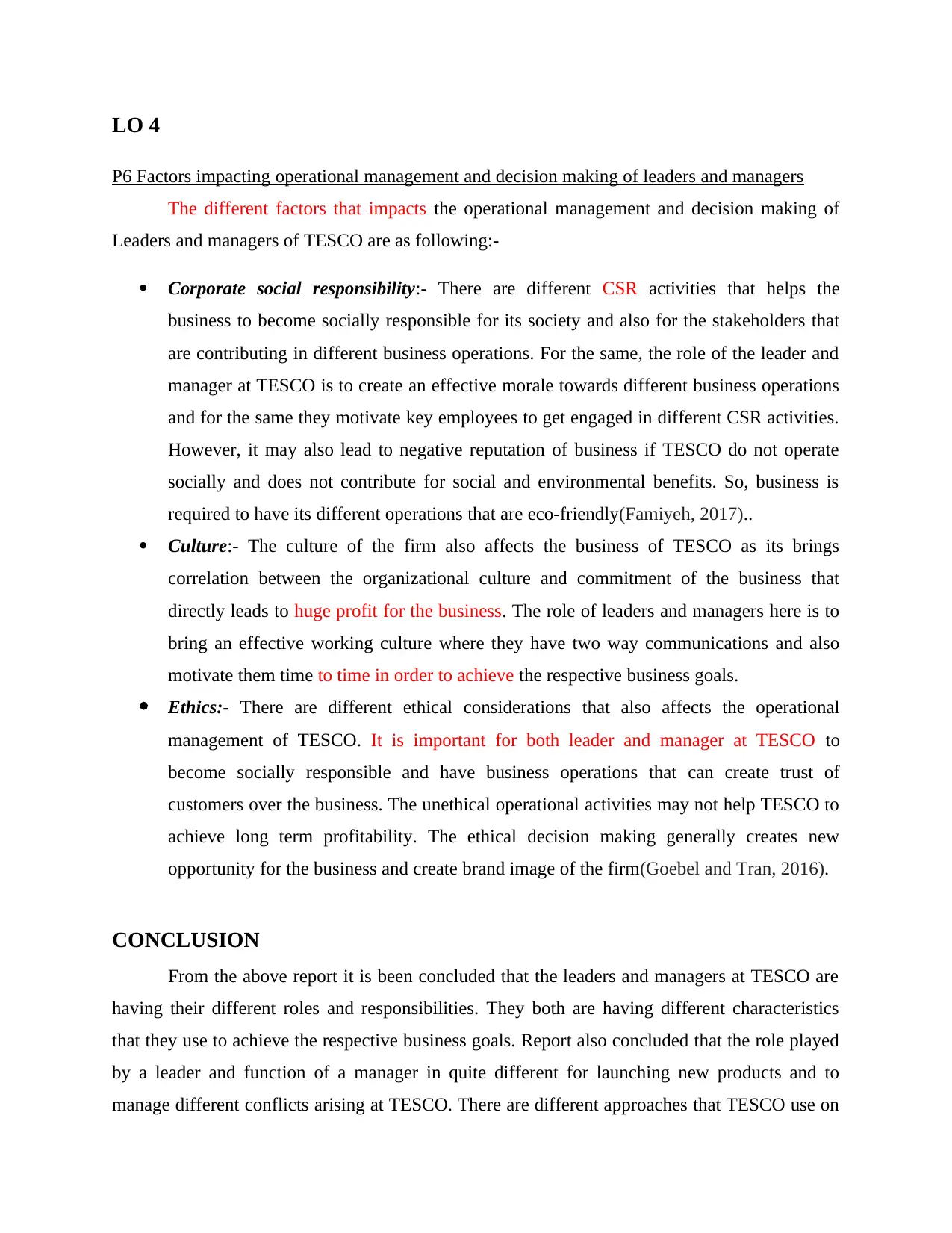
LO 4
P6 Factors impacting operational management and decision making of leaders and managers
The different factors that impacts the operational management and decision making of
Leaders and managers of TESCO are as following:-
Corporate social responsibility:- There are different CSR activities that helps the
business to become socially responsible for its society and also for the stakeholders that
are contributing in different business operations. For the same, the role of the leader and
manager at TESCO is to create an effective morale towards different business operations
and for the same they motivate key employees to get engaged in different CSR activities.
However, it may also lead to negative reputation of business if TESCO do not operate
socially and does not contribute for social and environmental benefits. So, business is
required to have its different operations that are eco-friendly(Famiyeh, 2017)..
Culture:- The culture of the firm also affects the business of TESCO as its brings
correlation between the organizational culture and commitment of the business that
directly leads to huge profit for the business. The role of leaders and managers here is to
bring an effective working culture where they have two way communications and also
motivate them time to time in order to achieve the respective business goals.
Ethics:- There are different ethical considerations that also affects the operational
management of TESCO. It is important for both leader and manager at TESCO to
become socially responsible and have business operations that can create trust of
customers over the business. The unethical operational activities may not help TESCO to
achieve long term profitability. The ethical decision making generally creates new
opportunity for the business and create brand image of the firm(Goebel and Tran, 2016).
CONCLUSION
From the above report it is been concluded that the leaders and managers at TESCO are
having their different roles and responsibilities. They both are having different characteristics
that they use to achieve the respective business goals. Report also concluded that the role played
by a leader and function of a manager in quite different for launching new products and to
manage different conflicts arising at TESCO. There are different approaches that TESCO use on
P6 Factors impacting operational management and decision making of leaders and managers
The different factors that impacts the operational management and decision making of
Leaders and managers of TESCO are as following:-
Corporate social responsibility:- There are different CSR activities that helps the
business to become socially responsible for its society and also for the stakeholders that
are contributing in different business operations. For the same, the role of the leader and
manager at TESCO is to create an effective morale towards different business operations
and for the same they motivate key employees to get engaged in different CSR activities.
However, it may also lead to negative reputation of business if TESCO do not operate
socially and does not contribute for social and environmental benefits. So, business is
required to have its different operations that are eco-friendly(Famiyeh, 2017)..
Culture:- The culture of the firm also affects the business of TESCO as its brings
correlation between the organizational culture and commitment of the business that
directly leads to huge profit for the business. The role of leaders and managers here is to
bring an effective working culture where they have two way communications and also
motivate them time to time in order to achieve the respective business goals.
Ethics:- There are different ethical considerations that also affects the operational
management of TESCO. It is important for both leader and manager at TESCO to
become socially responsible and have business operations that can create trust of
customers over the business. The unethical operational activities may not help TESCO to
achieve long term profitability. The ethical decision making generally creates new
opportunity for the business and create brand image of the firm(Goebel and Tran, 2016).
CONCLUSION
From the above report it is been concluded that the leaders and managers at TESCO are
having their different roles and responsibilities. They both are having different characteristics
that they use to achieve the respective business goals. Report also concluded that the role played
by a leader and function of a manager in quite different for launching new products and to
manage different conflicts arising at TESCO. There are different approaches that TESCO use on
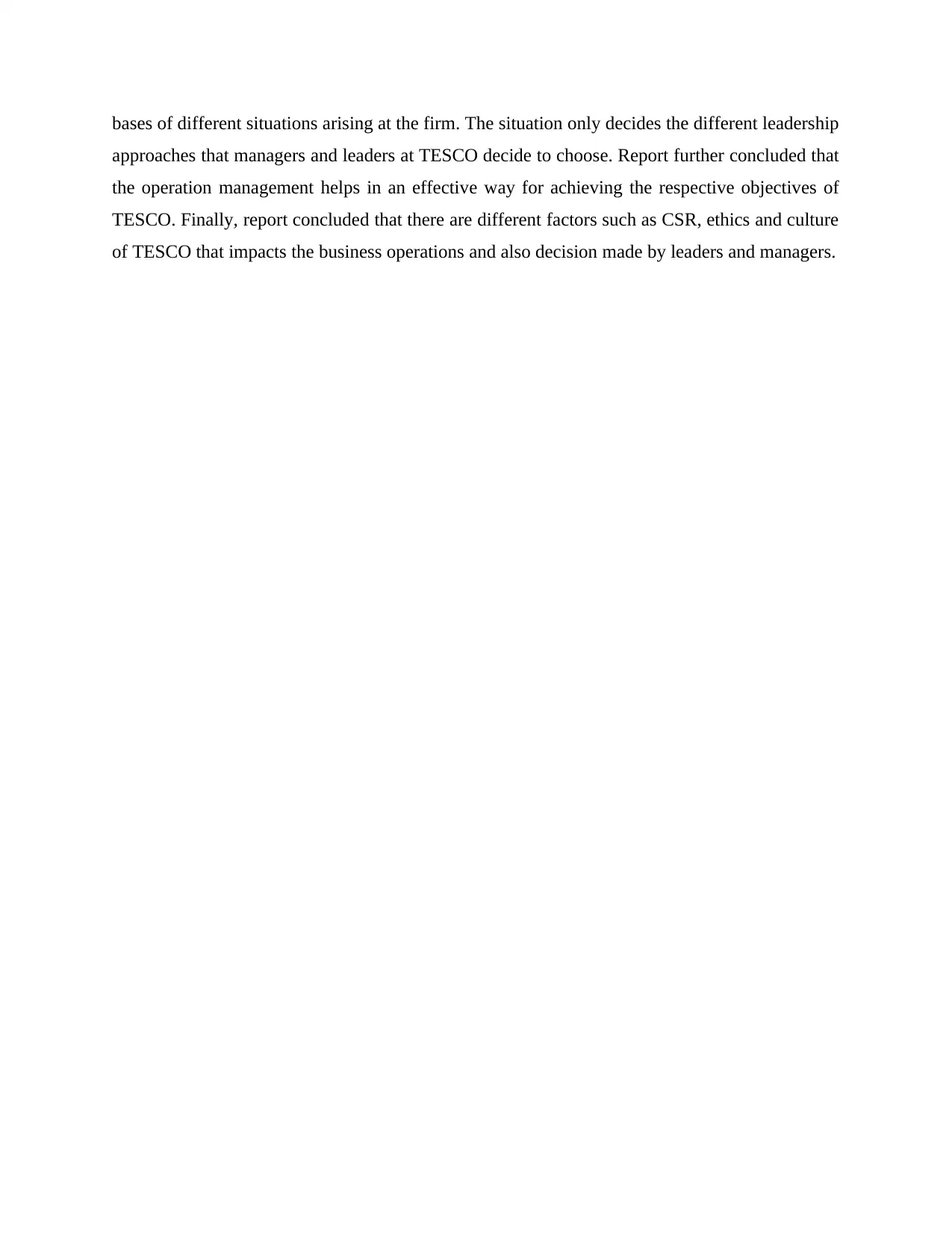
bases of different situations arising at the firm. The situation only decides the different leadership
approaches that managers and leaders at TESCO decide to choose. Report further concluded that
the operation management helps in an effective way for achieving the respective objectives of
TESCO. Finally, report concluded that there are different factors such as CSR, ethics and culture
of TESCO that impacts the business operations and also decision made by leaders and managers.
approaches that managers and leaders at TESCO decide to choose. Report further concluded that
the operation management helps in an effective way for achieving the respective objectives of
TESCO. Finally, report concluded that there are different factors such as CSR, ethics and culture
of TESCO that impacts the business operations and also decision made by leaders and managers.
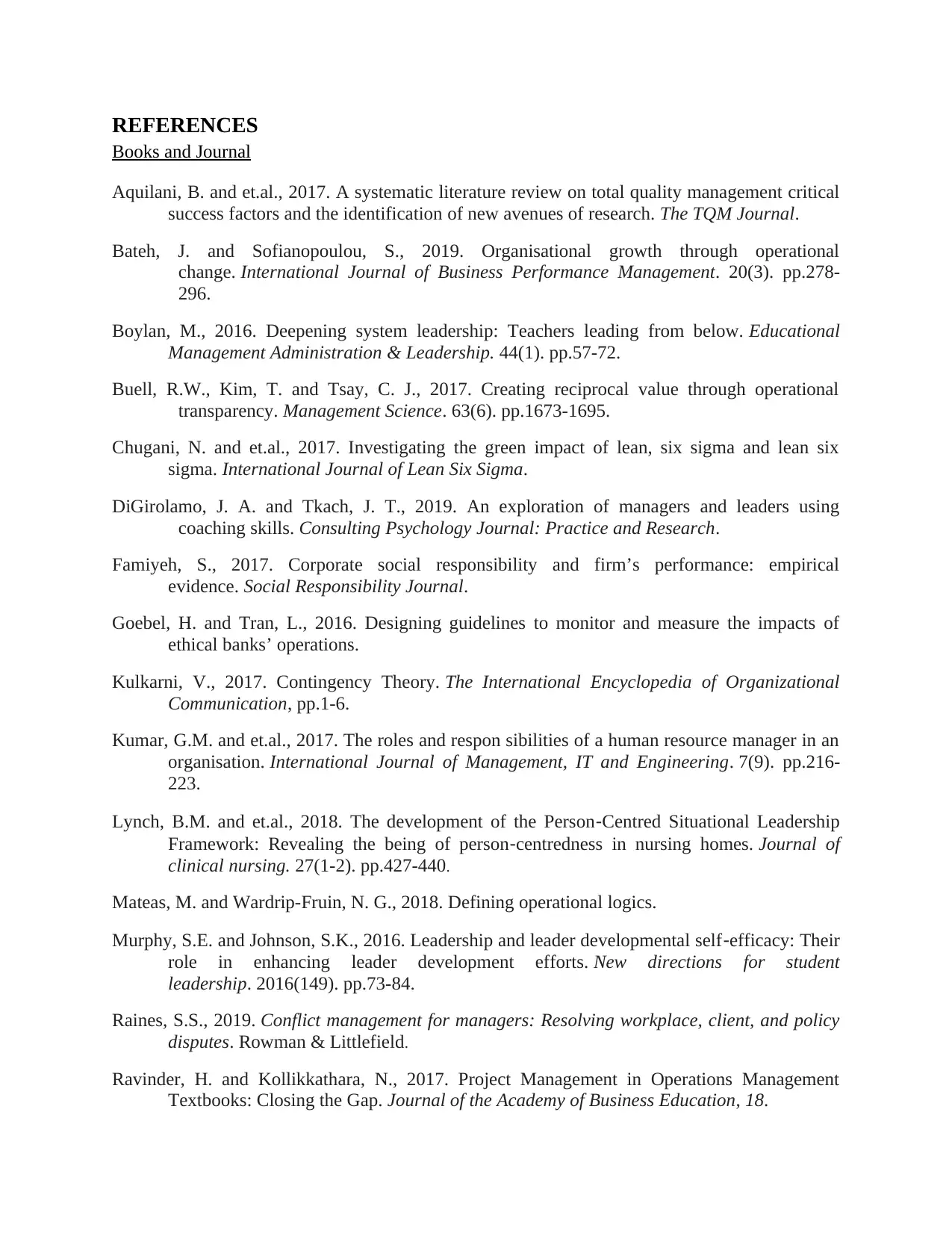
REFERENCES
Books and Journal
Aquilani, B. and et.al., 2017. A systematic literature review on total quality management critical
success factors and the identification of new avenues of research. The TQM Journal.
Bateh, J. and Sofianopoulou, S., 2019. Organisational growth through operational
change. International Journal of Business Performance Management. 20(3). pp.278-
296.
Boylan, M., 2016. Deepening system leadership: Teachers leading from below. Educational
Management Administration & Leadership. 44(1). pp.57-72.
Buell, R.W., Kim, T. and Tsay, C. J., 2017. Creating reciprocal value through operational
transparency. Management Science. 63(6). pp.1673-1695.
Chugani, N. and et.al., 2017. Investigating the green impact of lean, six sigma and lean six
sigma. International Journal of Lean Six Sigma.
DiGirolamo, J. A. and Tkach, J. T., 2019. An exploration of managers and leaders using
coaching skills. Consulting Psychology Journal: Practice and Research.
Famiyeh, S., 2017. Corporate social responsibility and firm’s performance: empirical
evidence. Social Responsibility Journal.
Goebel, H. and Tran, L., 2016. Designing guidelines to monitor and measure the impacts of
ethical banks’ operations.
Kulkarni, V., 2017. Contingency Theory. The International Encyclopedia of Organizational
Communication, pp.1-6.
Kumar, G.M. and et.al., 2017. The roles and respon sibilities of a human resource manager in an
organisation. International Journal of Management, IT and Engineering. 7(9). pp.216-
223.
Lynch, B.M. and et.al., 2018. The development of the Person‐Centred Situational Leadership
Framework: Revealing the being of person‐centredness in nursing homes. Journal of
clinical nursing. 27(1-2). pp.427-440.
Mateas, M. and Wardrip-Fruin, N. G., 2018. Defining operational logics.
Murphy, S.E. and Johnson, S.K., 2016. Leadership and leader developmental self‐efficacy: Their
role in enhancing leader development efforts. New directions for student
leadership. 2016(149). pp.73-84.
Raines, S.S., 2019. Conflict management for managers: Resolving workplace, client, and policy
disputes. Rowman & Littlefield.
Ravinder, H. and Kollikkathara, N., 2017. Project Management in Operations Management
Textbooks: Closing the Gap. Journal of the Academy of Business Education, 18.
Books and Journal
Aquilani, B. and et.al., 2017. A systematic literature review on total quality management critical
success factors and the identification of new avenues of research. The TQM Journal.
Bateh, J. and Sofianopoulou, S., 2019. Organisational growth through operational
change. International Journal of Business Performance Management. 20(3). pp.278-
296.
Boylan, M., 2016. Deepening system leadership: Teachers leading from below. Educational
Management Administration & Leadership. 44(1). pp.57-72.
Buell, R.W., Kim, T. and Tsay, C. J., 2017. Creating reciprocal value through operational
transparency. Management Science. 63(6). pp.1673-1695.
Chugani, N. and et.al., 2017. Investigating the green impact of lean, six sigma and lean six
sigma. International Journal of Lean Six Sigma.
DiGirolamo, J. A. and Tkach, J. T., 2019. An exploration of managers and leaders using
coaching skills. Consulting Psychology Journal: Practice and Research.
Famiyeh, S., 2017. Corporate social responsibility and firm’s performance: empirical
evidence. Social Responsibility Journal.
Goebel, H. and Tran, L., 2016. Designing guidelines to monitor and measure the impacts of
ethical banks’ operations.
Kulkarni, V., 2017. Contingency Theory. The International Encyclopedia of Organizational
Communication, pp.1-6.
Kumar, G.M. and et.al., 2017. The roles and respon sibilities of a human resource manager in an
organisation. International Journal of Management, IT and Engineering. 7(9). pp.216-
223.
Lynch, B.M. and et.al., 2018. The development of the Person‐Centred Situational Leadership
Framework: Revealing the being of person‐centredness in nursing homes. Journal of
clinical nursing. 27(1-2). pp.427-440.
Mateas, M. and Wardrip-Fruin, N. G., 2018. Defining operational logics.
Murphy, S.E. and Johnson, S.K., 2016. Leadership and leader developmental self‐efficacy: Their
role in enhancing leader development efforts. New directions for student
leadership. 2016(149). pp.73-84.
Raines, S.S., 2019. Conflict management for managers: Resolving workplace, client, and policy
disputes. Rowman & Littlefield.
Ravinder, H. and Kollikkathara, N., 2017. Project Management in Operations Management
Textbooks: Closing the Gap. Journal of the Academy of Business Education, 18.
Paraphrase This Document
Need a fresh take? Get an instant paraphrase of this document with our AI Paraphraser
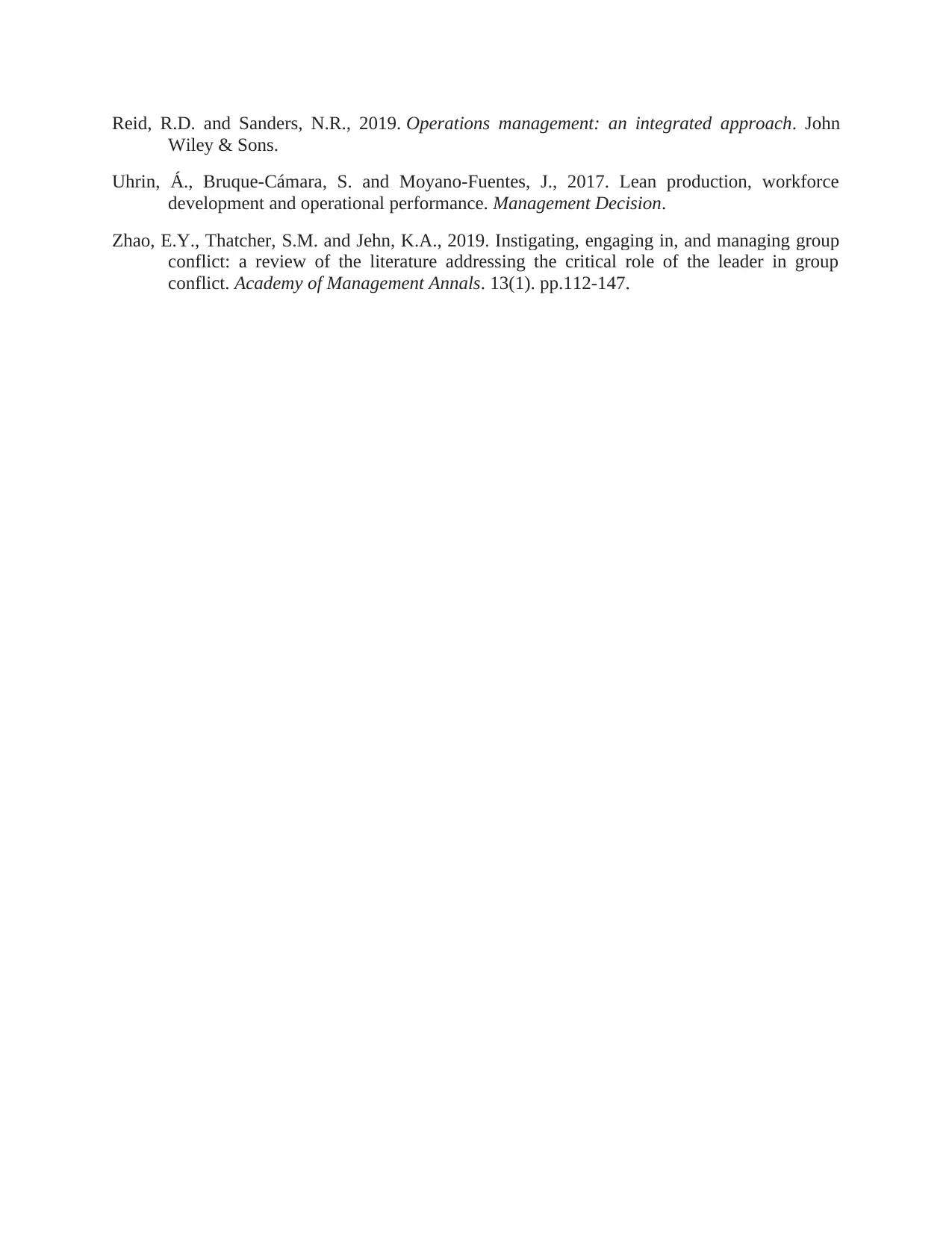
Reid, R.D. and Sanders, N.R., 2019. Operations management: an integrated approach. John
Wiley & Sons.
Uhrin, Á., Bruque-Cámara, S. and Moyano-Fuentes, J., 2017. Lean production, workforce
development and operational performance. Management Decision.
Zhao, E.Y., Thatcher, S.M. and Jehn, K.A., 2019. Instigating, engaging in, and managing group
conflict: a review of the literature addressing the critical role of the leader in group
conflict. Academy of Management Annals. 13(1). pp.112-147.
Wiley & Sons.
Uhrin, Á., Bruque-Cámara, S. and Moyano-Fuentes, J., 2017. Lean production, workforce
development and operational performance. Management Decision.
Zhao, E.Y., Thatcher, S.M. and Jehn, K.A., 2019. Instigating, engaging in, and managing group
conflict: a review of the literature addressing the critical role of the leader in group
conflict. Academy of Management Annals. 13(1). pp.112-147.
1 out of 14
Your All-in-One AI-Powered Toolkit for Academic Success.
+13062052269
info@desklib.com
Available 24*7 on WhatsApp / Email
![[object Object]](/_next/static/media/star-bottom.7253800d.svg)
Unlock your academic potential
© 2024 | Zucol Services PVT LTD | All rights reserved.





